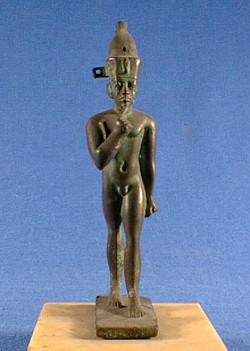
Greek name for the god 'Her-pa-khered', 'Horus the child', which in the Late Period covered all of the forms of the god as a child, such as Horus, the son of Isis and Osiris (Harsiese), and 'the young Horus', the personification of the young sun. Although a related god (in name) appears as early as the Old Kingdom, Harpocrates was only worshipped under this name from the New Kingdom on. There are numerous bronze statues of the god showing him as a child with the sidelock of youth and a finger to his mouth. In the Graeco-Roman Period, many terracotta statues of him were made, again with the above-mentioned characteristics and often seated on an animal (the animals associated with the god Amun-Re, such as a ram or a goose, were the most popular) or in a solar bark. In addition, there are representations of a child on a lotus flower, also linked to the sun. The god is often wearing the crowns of Egypt. All these forms are connected with his role as the personification of the young sun. The presence of the child Horus on magical stelae also has solar aspects - he is being equated with the god Bes (the old sun); in addition, by representing him overcoming dangerous animals, he is also playing the role of Harkhebis or Harsiese. As a bringer of fertility, partly as a result of his being a child of Osiris, he is often represented with a sheaf of corn (associations with Neper) or with a disproportionately large penis (related to Amun-Min). Finally, the god also plays the role of the child of a divine triad and is thus linked to the mammisi of the temples, where the birth of the divine child was celebrated.